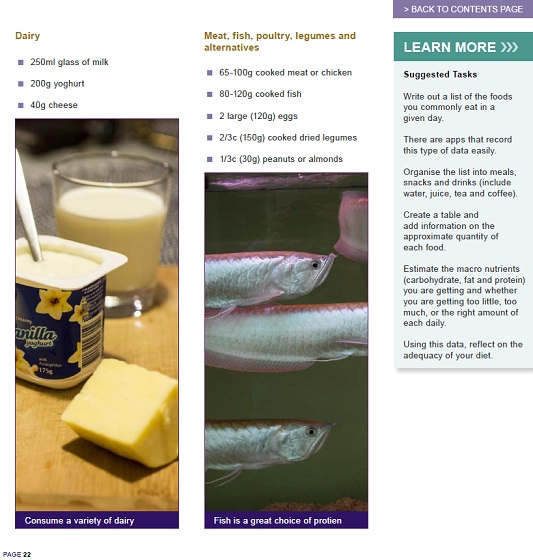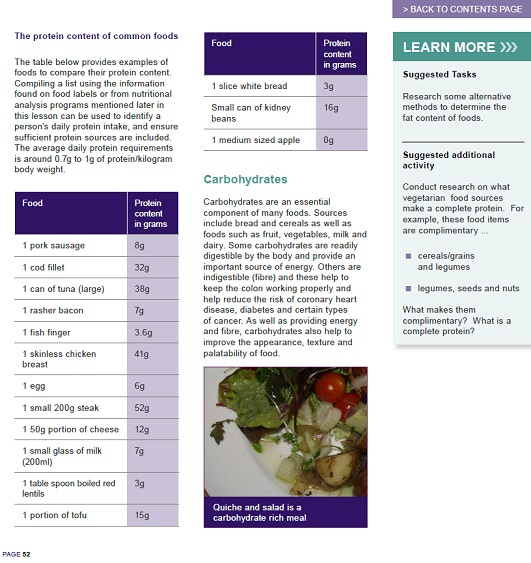Sneak Peek
Introduction to Food and Nutrition We are what we eat
 If you care about yourself, your family and those you work with, it only makes sense to get a proper understanding of what you eat, and how it is processed in your body.
If you care about yourself, your family and those you work with, it only makes sense to get a proper understanding of what you eat, and how it is processed in your body.
- If your work involves helping others to a better state of wellbeing, again, it makes perfect sense to get a better understanding of food and nutrition.
This is a short course designed to help you learn what everyone should know, but probably doesn’t know.
- It provides excellent professional development for people working in a health food shop, a gym, or a medical service.
- It provides health and wellbeing professionals with an opportunity to fill in gaps in their knowledge or broaden the scope of services they might offer their clients
- It provides a starting point for anyone considering a career or business in the food or nutrition industry.
- It provides an opportunity to improve your own health and wellbeing.
- Make Better Choices when Buying Food
Course Contents
There are five lessons in this course, with things to read and things to do (beyond the reading) in each lesson. At the end of each lesson, you will have the opportunity to review what you learned, by answering automated self assessment tests.
At the end of the whole course; you have the opportunity to undertake an online examination (optional) and if you pass, you will be awarded a Certificate of Completion
The lessons cover the following topics:
Lesson 1 The Digestive System
This provides an overview of nutrition and nutrients. You discover food pyramids (old and new), and the “Eatwell guide”. Learn about new ideas for recommended daily intake (rdi), population based nutrient requirements, digestion, and recommendations including examples of serving size. This lesson also covers the biology of the human digestive system.
Lesson 2 Modifying Diet for a Particular Lifestyle or Genetic Disposition
Learn about how nutrition can be affected by lifestyle, cultural and genetic factors. Discover the way in which how you eat can affect your health just as much as what you eat.
Lesson 3 Foods and Their Nutrition
To this point in the course you may be starting to understand what you should eat; but now you need to learn more about why you eat and where to get good food from. Not all carrots are the same! Obviously fresh is best; but other factors come into play as well. A lot of foods contain preservatives, or may be prepared in ways that might not be ideal. Learn about the impact of food preparation and storage on nutritional value.
Lesson 4 Nutrition and Health Disorders
What you eat does affect different parts of your body in different ways. If you have problems with your skin, digestive system, respiration, heart or some other part of your body, it may be that better management of your diet could help with that problem. Even your mental health can be affected by diet. This lesson helps you to understand how better food choices can impact upon different parts of the body.
Lesson 5 How to Find Reliable Information on Nutrition
There is a lot of contradictory information to be found when you start reading about food and nutrition. It is important to understand that not all sources of information are reliable; but also that everyone is different in their nutritional needs. Just because one food is bad for you, doesn’t mean it is bad for everyone.
If you are going to make wise decisions about eating for yourself or anyone else, it is important to know how to evaluate the different needs of different bodies; and how to discern what is reliable information to use This lesson helps you with precisely these issues; and in doing so, sets you up for continued, effective learning about human nutrition, long after you complete this course.
Support from Expert Tutors
You have access to expert tutors through our student help desk all the time you are studying this course. Our school maintains help desks in both of our offices -in Australia and the UK; and has staff on duty five days a week manning phones, online chat and emails. Any questions that you have about what you are studying will be dealt with promptly (usually the same working day, often immediately).
If there is something you read or research that you don't understand, ask for help.
If you want to learn more about something you encounter through these studies, have a conversation with one of our faculty tutors
If you need direction to find more information, ask
If you need advice on moving forward with your work, career or studies after the course ask. (Free career and business advice).
Examples of Pages from this Course


LEARN TO UNDERSTAND HOW FOOD WORKS IN THE HUMAN BODY
The effect of food upon the body is not only influenced by what is eaten, but also by how it is eaten. For example:
If food is chewed more in the mouth, it will be more broken up before it moves through the digestive tract.
- If food remains longer in the mouth, more saliva may be produced, and digestion through the effect of saliva may be more advanced.
- If food is cut up, minced or blended before ingestion, there may be a greater and faster penetration of digestive juices into the food.
- The order in which foods enter the digestive tract may impact upon digestion.
- The frequency of eating may impact on digestion (e.g. lots of small meals, or fewer large meals).
Eating only one type of food at a time is thought to allow better digestion. This is the principle behind "food combining". For example, if carbohydrate is eaten without fats and proteins the digestive tract will produce gastric juice containing enzymes to digest only carbohydrate. With only "pure" digestive juices, digestion may be more effective.
Compatibility of Ingredients
While it is important to vary your diet, casually mixing in lots of different ingredients is not the best approach. Some foods are better not to be eaten together with certain other foods due to the different digestive processes in the stomach.
Starches and meats are both slow to digest, so when combined they slow down the digestive system. If a person has a fast digestive system this is not a problem, and it may help to abate hunger. However, for those with a slower system the combination can exacerbate the problem and also hamper the immune system. This may trigger other chronic health conditions.
Examples of incompatible and compatible combinations:
- Avoid protein and starch at a single meal. To digest proteins your body needs an acid base, but to digest starch your body needs an alkaline base. Combine either protein or starches with leafy green vegetables or other non-starchy vegetables.
- Only ever eat fruit by itself (not in combination with other foods). Fruit is quick to digest and when consumed with slow digesting food the fruit tends to ferment. Don’t mix acid type fruits e.g. oranges, grapefruits etc. with sub-acid fruits such as apples, grapes, nectarines and peaches.
- Leave a gap between foods that do not combine well, i.e. protein and starches and fruits. For example, 4 hours between eating protein and then eating starch or fruit, 3 hours between eating starches and then eating proteins or fruit, and 2 hours between fruit and then eating protein or starch.
WHO CAN BENEFIT FROM THIS COURSE?
Most people today understand there is good and bad food; but not a lot of detail. With lots of different experts in the media spruiking different foods, diets, and nutritional ideas; it is easy to become confused.
The only real way to make an informed decision about what to eat, is to have a fundamental and broad understanding of the science of food. While we all have common needs, we are also all individuals, and each individual has different food needs to the next.
This course can help:
- you with your own food choices
- food suppliers or food service suppliers; from restaurateurs and food retailers to growers and food processors
- parents providing food for their families
- anyone contemplating a career with food (this course can be a starting point, laying a foundation and broadening your understanding of where you might move to develop a career).
How does this course work?
You can enrol at any time.
Once you have paid for the course, you will be able to start straight away.
Study when and where you like. Work through at your own pace.
You can download your study-guide to your smart phone, tablet or laptop to read offline.
There are automated self-assessment tests you can complete at the end of each lesson. You can attempt these as many times as you wish and each time, upon completion, you can see your results. You will need internet access to complete the self assessment tests.
At the end of the course, you are presented with a large assessment which can be attempted online, anywhere, anytime. If you achieve a 60% pass in the exam; you immediately receive a downloadable certificate of completion with your name on it. If you do not achieve a 60% pass rate, you can contact us to re-sit your exam. ( email- admin@acs.edu.au )
Contact us at anytime if you have any issues with the course. admin@acs.edu.au